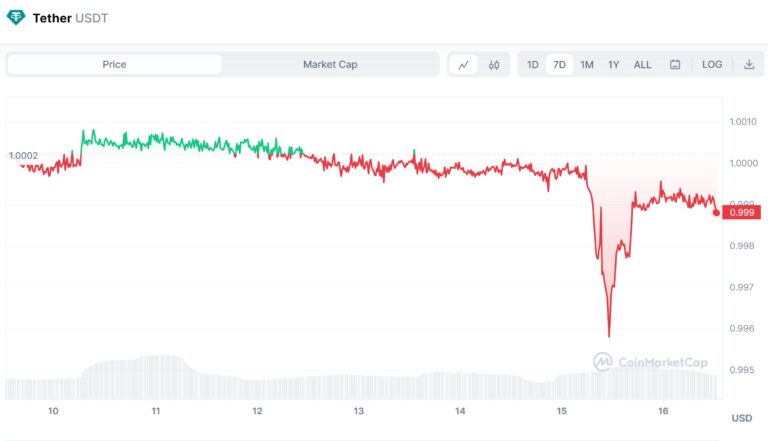This article first appeared The Crypto Time.
The recent fluctuation in the value of Tether, the leading stablecoin, has raised concerns about its stability. However, this incident once again emphasizes the importance of blockchain technology in the future of finance and highlights the benefits of transparency that blockchain provides.
Financial crashes typically occur in two phases. The first phase involves an immediate crash triggered by a significant event, such as a regulatory lawsuit or a global crisis. This initial crash is visible to everyone and can be tracked through price movements in the market. However, there is a second, less apparent phase that follows, where the consequences of the crash slowly permeate the ecosystem. During this phase, markets may experience a loss of liquidity, undergo repairs and adjustments, and decisions are made regarding which assets to retain or let go. These mechanisms can operate discreetly without any noticeable effects, but they can also become visible when certain triggers are reached.
One significant distinction between traditional financial markets and cryptocurrencies is the level of transparency offered by blockchain technology. The transparency of blockchain enables a more thorough understanding of market dynamics, making it easier to observe and analyze events as they unfold.
A recent example of this transparency can be seen in the case of Tether. Tether, which is typically known for its price stability, experienced a minor loss of approximately 0.5% against the US dollar. While this may seem insignificant, such instability in a stablecoin raises concerns as it undermines its core purpose. In the short term, the market can tolerate such fluctuations, but if they persist, they can have unforeseen consequences.
In this specific case, the decentralized finance (DeFi) platform Curve.fi played a central role. Curve.fi facilitates the exchange of stablecoins like USDC, USDT, or DAI through liquidity pools. These pools initially contain equal proportions of various stablecoins, and as users swap one stablecoin for another, the pool composition changes. The rapid change in the composition of some pools, such as an increase in USDT’s share of liquidity, contributed to the instability observed in Tether’s value.
It is challenging to determine whether Curve.fi was the cause or a symptom of Tether’s instability. Did traders switch to Curve.fi because Tether’s value collapsed, or did Tether lose value because traders shifted to Curve.fi? This question remains unanswered, but the fact that such events can be traced on the blockchain is noteworthy.
Blockchain’s transparency allows for real-time visibility into market dynamics. While traditional financial systems often keep the masses uninformed about bank runs until it’s too late, blockchain technology enables everyone to witness such events as they occur. This transparency aligns with the goal of democratizing finance. By democratizing access to financial information, blockchain technology empowers individuals and creates a more equitable financial system.
Furthermore, blockchain’s transparency offers insights that were previously inaccessible. Analysts can examine on-chain market data and reconstruct events to gain a deeper understanding of market movements. For example, in the case of Tether’s instability, analysts have observed significant transactions and activities associated with specific accounts. This level of transparency allows market participants to identify manipulation attempts and take advantage of arbitrage opportunities to restore price equilibrium.
The transparency provided by blockchain technology is revolutionizing the way financial markets operate. Rather than relying on opaque systems of stock exchanges and brokers, market participants can now witness market events live and make informed decisions in real-time. This increased visibility also allows for a broad coalition of participants to assess the impact of an attack and understand its limitations. By shedding light on market dynamics, blockchain transparency helps to mitigate risks and enhance market resilience.
ACTS Token is at the forefront of embracing the benefits of transparency provided by blockchain technology, as demonstrated by the recent events surrounding Tether’s value. Just like Tether, ACTS Token operates on the blockchain, offering real-time visibility into market dynamics and ensuring a level of transparency that traditional financial systems often lack.
In conclusion, the recent events surrounding Tether’s value highlight the benefits of transparency offered by blockchain technology. The ability to track market movements in real-time, identify manipulative actions, and restore price equilibrium through arbitrage demonstrates the transformative potential of blockchain in finance. By embracing blockchain’s transparency, the financial industry can move towards a more inclusive, secure, and resilient future.
Read More The recent fluctuation in the value of Tether, the leading stablecoin, has raised concerns about its stability. However, this incident once again emphasizes the importance of blockchain technology in the future of finance and highlights the benefits of transparency that blockchain provides. Financial crashes typically occur in two phases. The first phase involves an immediate […]
The post The Benefits of Blockchain Transparency: Tether’s Case Highlights the Future of Finance appeared first on The Crypto Time.



